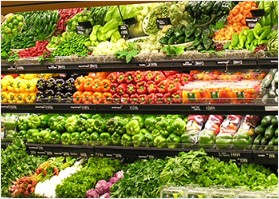
For independently owned grocery stores to stay competitive with nation-wide retailers like Costco and Wal-Mart, having the latest point of sale (POS) hardware is essential for both customer and employee experience. While there is no replacement for knowledgeable, friendly cashiers, the checkout line is the nexus of the grocery store experience. A bogged down point of sale severely limits an independent retailer’s ability to effectively manage long queues, ultimately sacrificing their business to larger chains. Outdated and inefficient scanners at the POS means longer lines, frustrated customers and abandoned purchases. A POS upgrade can be a simple yet effective solution to many of the challenges faced by independently owned grocery stores today.
Staying on the Forefront of POS Technology
A modern retail management system can narrow the gap between independent grocers and larger chain supermarkets. People often prefer the feel of a locally owned and operated grocery store to that of a larger chain, but in order to retain a loyal customer base, maintaining high quality equipment that serves the needs of the customer is a must. It is imperative for independent retailers to be on the forefront of technological POS advancements to stay competitive amongst the nationwide conglomerates. Smartphone use is constantly increasing as it integrates itself into virtually every aspect of the modern world, retail included. Being able to easily accept mobile coupons, pay via phone, scan items without concern for damaged barcodes, and weigh items quickly and accurately to reduce shrink are all elements that a store should consider when assessing their current stations and maximizing checkout efficiency.
Effective Mobile Couponing
As mobile couponing becomes more widespread, it is important to implement equipment that can actually process electronic discounts. If you can’t accept a mobile coupon, customers may end up buying those products elsewhere, lowering your profits and decreasing the likelihood of the customer returning.
And while some POS systems do accept these coupons, a customer usually must either hand the phone to the cashier to scan, or the cashier must use a handheld scanner (relying on steady hands from both parties) to input the coupon code. Unfortunately, there is always the unwanted possibility of a dropped phone in this exchange, causing the grocer to be held liable for damages to the customer’s phone.
Customer Side Scanners
State-of-the-Art checkout scanners now include customer side scanners for both ease of use and liability concerns. If the customer is able to use their phone to enter their loyalty information or coupons, scan an impulse buy at the counter, or even—eventually—make mobile payments, the cashier can focus on improving your store’s efficiency while the customer is supplied with an effortless way of entering information or discounts.
Versatility in Scanning Speeds up the Process
New scanning equipment also uses better quality laser scanning, with both vertical and horizontal scanning windows and omni-directional symbol orientation, helping to improve overall scanning speed. Many of these units can read barcodes even when they’re under plastic wrap, damaged or worn, faded, or poorly printed. Older scanning units can have scratches on their glass platters, increasing the time it takes to move items through the checkout line. Newer models use glass that is scratch resistant, limiting lost time and helping items ring up smoothly. Although lines may be long, with modern POS equipment discouraged customers may be surprised by the short wait times, therefore increasing customer satisfaction.
Maintenance Made Easy
POS maintenance can also be an issue for independent supermarkets. With the advancements of technology, checkout lanes and their hardware are not immune to obsolescence. As equipment ages, it can become more difficult to service, taking longer and costing more in both labor and downtime. And while upgrading your store’s POS can cause concern—you might worry that it would be too costly or time-consuming, or even call for altering the structure of the checkout counter—products are now available that can reduce the total cost of ownership, lowering the time needed for servicing and overall power consumption. They’re easy to install, use a minimal number of parts, and have no moving pieces, thereby providing fewer failure points. Also, the housing of newer systems is often secured without screws, increasing accessibility for technicians and lowering checkout downtime.
What to Expect From Reputable Service Providers
As a Point of Sale IT solutions and service provider, POS Remarketing Group is committed to helping your store manage every need at any phase of your equipment life cycle—from preventative maintenance and onsite repair to custom configurations made to order from our partnered, reputable brands. To stay competitive with nation-wide retailers and supermarkets, your equipment makes a difference to both customer and employee experience.
As experts in POS servicing and maintenance, POSRG can make these possibilities a reality, helping you acquire and implement a new checkout system that that will keep you competing with larger retailers. Upgrading your POS hardware is one of the easiest and most rewarding means to boost profits, reputation, and customer satisfaction.
Contacting Us
If you’re interested in our services, we can be reached at www.posrg.com. We are confident that we can help with any POS or IT issue and provide valuable solutions. We will be present at this year’s National Grocers Association Show, occupying Booth 1015, where we’ll be showcasing the Zebra MP7000, a top of the line checkout scanner with some of the technology and features mentioned in this article. The details of our exhibition can be found here. Stop by and say hello, and we’ll be happy to show you our knowledge and expertise firsthand.